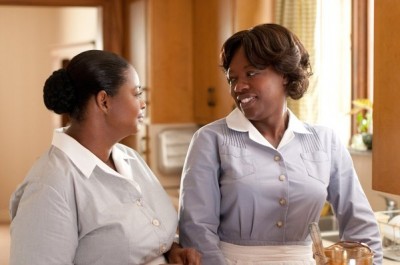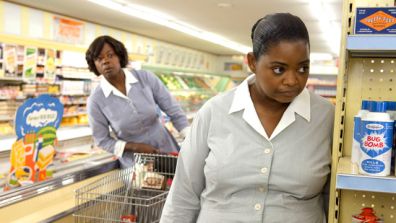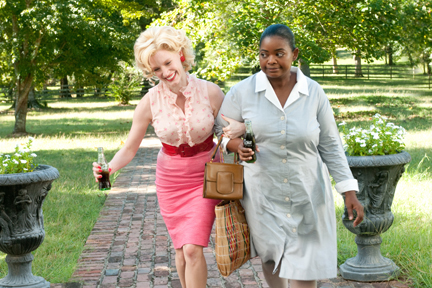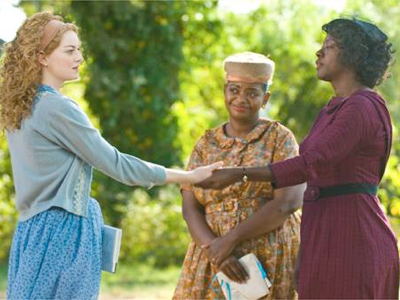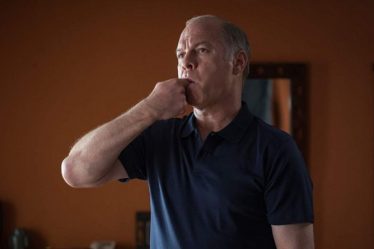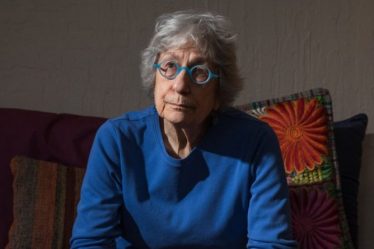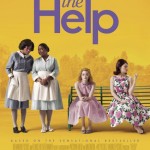
Saturday, August 13, 2011
Tate Taylor, who told his close friend, New York Times Bestselling “The Help”‘s writer Kathryn Stockett not to give up as he read the manuscript on an airplane, started writing the screenplay for the film before the book was even finished. In this screenplay he used his best friend as inspiration for one of the main characters. He so believed in the need for this film, he eventually wound up in a room talking Steven Spielberg and Dreamworks into making it, and became its director.
He had only one other feature to his credit as a director, a little known movie for which he also wrote the screenplay, “Pretty Ugly People”.
It sounds almost like a barnyard musical with Judy and Mickey. I start this review with this background, because the story of how it and the book itself got noticed and embraced, the passion and determination it took, is evident in much of this movie.
From the production design, which is so meticulous as to build the south of the 60s, and Mississippi into another character, to the writing, which allows multi dimensional characters in what could have been a movie with cliched cut outs as sappy southern as Bourbon Pecan pie, to the music, which remains subtle enough to support rather than serenade, intention, commitment, and love of the subject can be seen everywhere.
Yet of all the great aspects of this movie, which I should warn you has a decidedly Fried Green Tomatoes vibe, so if you didn’t like that movie, you won’t like this one, the acting is by far what most recommends it. Steadfast fans of Emma Stone who have been defending her as more than just this year’s ingenue can crow that she not only holds her own but matches the remarkable performances by Viola Davis and Octavia Spencer.
The story is of 3 women who build an unlikely friendship when Old Miss grad “Skeeter” Phelan (Emma Stone) begins writing a book called “The Help” with stories told from the perspective of black maids in Jackson, Mississippi and begins with writing the experiences of Aibileen (Viola Davis) and her friend Minny (Octavia Spencer) in hopes of bringing to light appalling and unacceptable inequalities. The story is largely told from Aibileen’s perspective, with her narration. Viola Davis dominates as the mother to both her own child and the many children of white families, who suffers racism and exclusion with stoic grace. Let’s hope she’ll be noticed at awards season. Octavia Spencer is director Tate Taylor’s closest friend, but he had to fight to get her the role of Minny, even though he used her as inspiration for her as he wrote the screenplay. Although many well known African American actresses in Hollywood vied for the it, once you see her in the role, it’s hard to imagine anyone else doing a better job.
Great performances are also seen by Bryce Dallas Howard as the Southern Junior League queen bee Hilly Holbrook who should be wearing a 60s couture klan robe, and Jessica Chastain as Celia Foote, the sweet outsider who hires and befriends Minny and is anything but white trash.
The number of male roles is commensurate with the number or female roles in the usual shoot em up, which is to say they might all share 10 pages of dialogue between them. Good for the girls, all of whom get juicy roles they can wring for every emotional nuance. Finally, a movie carried by women not lowering itself to the lowest common denominator or settling for a script with the depth and quality of a romance on the Lifetime Network.
There is a cadence to the dialogue and story that is decidedly Southern, so that scenes of the darker aspects of life as a person of color in 60s South, shockingly racist action, sweet southern humor, and charm flip back and forth to keep us watching and on our toes. It feels very much like a Southerner telling us a story, and we are ably pulled unexpectedly between laughter and discomfort
As to the weaker points, it could be a bit shorter, and a bit less Kumbaya, and may even dip from time to time into a Disney-fied version of the Civil Rights era, but the sass and the fear often on the faces of the women risking everything to tell their stories gives an underlying tension to the story that seems to reflect the era honestly enough. If it seems a bit too picturesque, it might be because Southern folk made it in the South. Frequent arguments are made about anything that doesn’t give the raw Sam Peckinpah version of American history. News to nay-sayers: even in the racist South of our past, women banded together for change, laughed together, and experienced sisterhood.
Well, let us have this one. It’s beautiful to both look at and watch. So just excuses us sisters (and the fearless men out there) while we support “The Help”. They deserve it.


